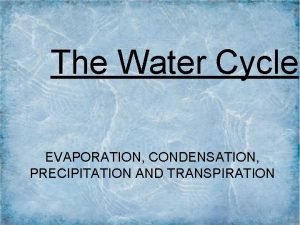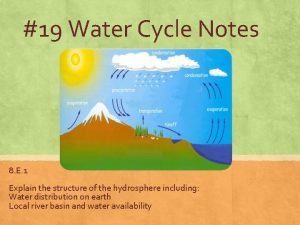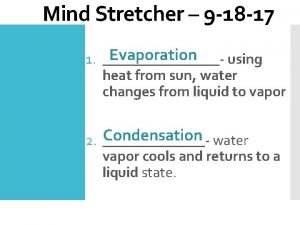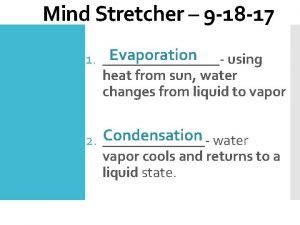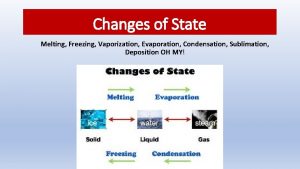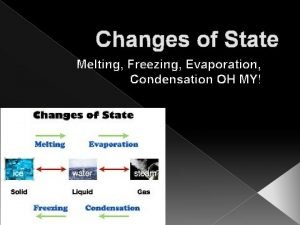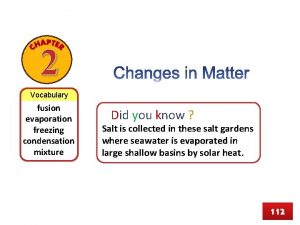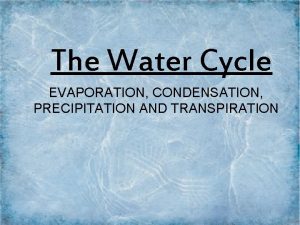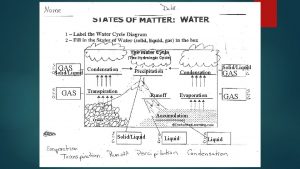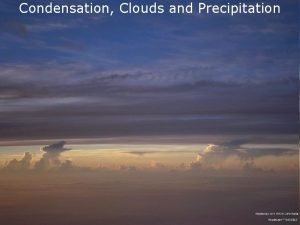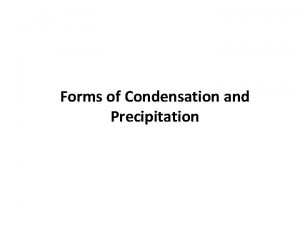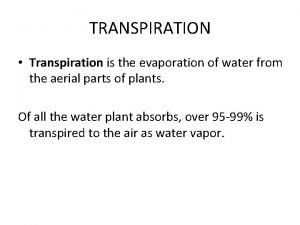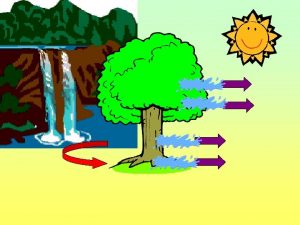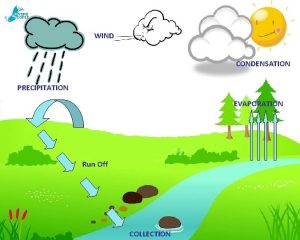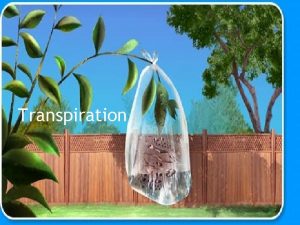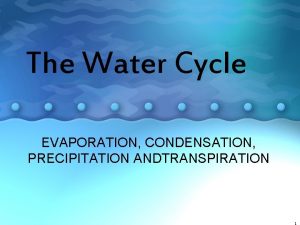The Water Cycle EVAPORATION CONDENSATION PRECIPITATION AND TRANSPIRATION











- Slides: 11

The Water Cycle EVAPORATION, CONDENSATION, PRECIPITATION AND TRANSPIRATION

The earth has a limited amount of water. • The earth’s water keeps going around in what we call the "Water Cycle. ” This cycle is made up of a few main parts: 1. evaporation 2. condensation 3. precipitation 4. transpiration 5. run-off

CONDENSATION TURNS INTO WATER DROPLETS Precipitation “tree sweat”—plants lose water to the atmosphere Water as liquid changes to a gas with heating from the sun. & run--off

A. Evaporation- Liquid to Gas Evaporation is when the sun heats up water in rivers or lakes or the ocean and turns it into vapor or steam. The water vapor or steam leaves the river, lake or ocean and goes into the air. Water to water Vapor

B. Condensation- Gas to Liquid Water vapor in the air gets cold and changes back into liquid, forming clouds. This is called condensation. Example: the droplets that form on the outside of a cold glass. The water vapor condensed into water droplets.

C. Precipitation • Precipitation occurs when so much water has condensed that the air cannot hold it anymore. • The clouds get heavy and water falls back to the earth in the form of rain, hail, sleet or snow.

D. Transpiration • Transpiration is the process by which plants lose water out of their leaves.

E. Run-off • Water that has fallen as precipitation falls back to the earth where it does one of two things – Water goes into the ground & becomes ground water – OR it returns to rivers, lakes, & streams and makes its way back to the oceans


Review of the Main Parts of the Water Cycle A. Evaporation- Liquid to Gas Water changes to water vapor B. Condensation- Gas to Liquid Water vapor cools in the atmosphere and forms small droplets. C. Precipitation- Small droplets of water come together and form large droplets and fall to Earth • Click below for more about the Water Cycle. http: //www. kidsgeo. com

Interesting Facts • Water droplets before they precipitate to earth combine with millions of other droplets until they become heavy enough to fall. • The average speed of a raindrop is 14 miles an hour and is only. 04 to. 24 inches in diameter. – A raindrop must be at least. 02 inches big otherwise it is considered drizzle. In illustrations raindrops usually are drawn tear shaped, but actually look more like the top of a hamburger bun. • According to the USGS, you may drink the same water as a dinosaur did 180 -245 million years ago. • Frozen water is 9% lighter than water, which is why ice floats on water. • Click below for more interesting facts about water. – http: //www. lenntech. com/water-trivia-facts. htm – http: //www. njawwa. org/kidsweb/waterfacts. htm
 Condensation evaporation precipitation
Condensation evaporation precipitation Water cycle transpiration
Water cycle transpiration Prep 1
Prep 1 Prep 1
Prep 1 Transpirasi adalah
Transpirasi adalah Examples of phase change
Examples of phase change Particles of condensation
Particles of condensation Condensation melting freezing evaporation
Condensation melting freezing evaporation Fusion evaporation condensation
Fusion evaporation condensation Water and water and water water
Water and water and water water Steps of gravimetric analysis
Steps of gravimetric analysis Co precipitation and post precipitation
Co precipitation and post precipitation
